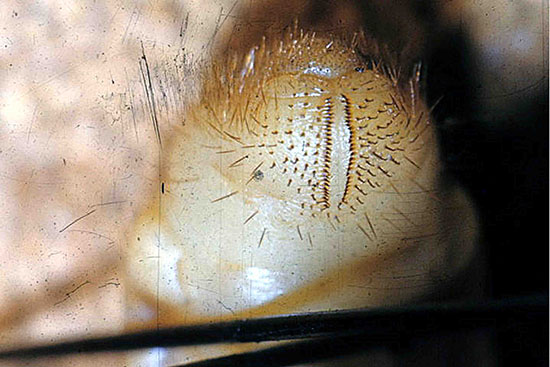Issue 5, May 26, 2015
May Beetles
There are many species of the genus Phyllophaga, also known as true white grubs or May beetles that occur in Illinois. Their larval stage is one of the genera known as white grubs that feed on turfgrass roots. While Japanese beetle, Popillia, and masked chafer, Cyclocephala, larvae or white grubs feed only on the roots of grasses, true white grubs also feed on dead organic matter. For that reason, they are commonly found in flower beds, under dead logs, and in mulch causing no apparent damage.
All true white grubs can be distinguished from others by their raster pattern of two parallel rows of thick setae or light spines on the underside of the last abdominal segment. Different species of Phyllophaga can be distinguished by the number of setae per row and the amount and location of divergences of the two rows.

True white grub raster.
The most familiar species have three-year life cycles and are commonly known s three-year white grubs. In the second year of the life cycle, large grubs are present through the growing season, causing concern to turf managers. Heavy infestations are sporadic in appearance, but can cause severe turf injury like that caused by the more common Japanese beetle and masked chafer larvae. True white grubs have lower water requirements than other white grubs, and commonly damage non-irrigated turf.

True white grub adult.
Adult May beetles feed on oak, crabapple, ash, and other tree foliage at night in the spring (May), eating at the leaf margin to the mid-vein. Damaged tree leaves with no apparent responsible insect during the day may be due to May beetle feeding. Verify the cause by scouting the foliage after dark with a flashlight; adults hide in turf during the day. Most three-year white grub adults are about one-inch long stocky dark brown to reddish brown beetles. In southern Illinois, one of the common May beetle species has a one-year life cycle and is a one-half inch long, tan adult beetle. Spring sightings of what appear to be adult masked chafers are usually this species.
Three-year white grubs are typically controlled with insecticide applications applied to control Japanese beetle or masked chafer grubs. However, three-white grub infestations commonly occur in non-irrigated areas that are not usually treated. Large larvae are commonly discovered that are best controlled with insecticidal nematodes, particularly Heterorhabditis bacteriophora (Hb nematodes). The higher cost of the nematodes and the need for irrigation before and after application can make treatment problematic.
Adult feeding on tree foliage is usually not heavy enough to warrant treatment. If needed, a single application of carbaryl (Sevin) or a pyrethroid will provide control. (Phil Nixon)
Author:
Phil Nixon